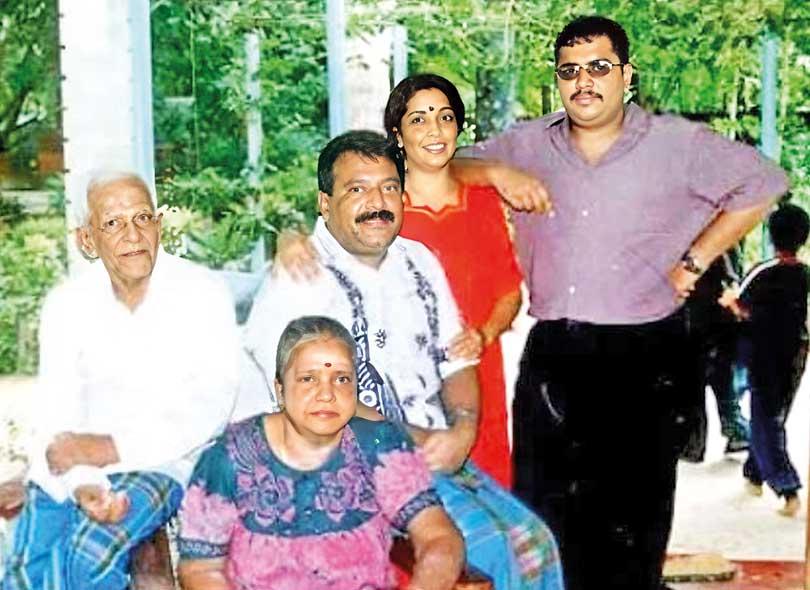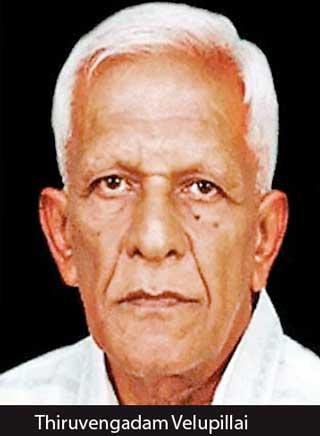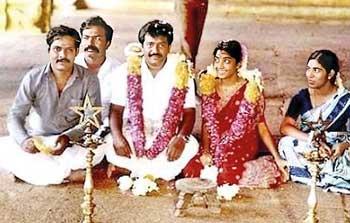13 May 2023 - {{hitsCtrl.values.hits}}

| The name Prabhakaran means the Sun or Sooriyan. Later his sycophants and acolytes began calling him Sooriyathevan or Sun God. Being the youngest in the family he was called Thambi or younger brother. This pet name continued to be in vogue when he entered militant ranks as he was then perhaps the youngest of all |
| An incident on the day of the Indian festival Holi resulted in a new relationship blossoming between the Valvettithurai lad and Pungudutheevu lass |
By D.B.S.Jeyaraj
 The demise of Liberation Tigers of Tamil Eelam (LTTE) leader Veluppillai Prabhakaran occurred fourteen years ago.
The demise of Liberation Tigers of Tamil Eelam (LTTE) leader Veluppillai Prabhakaran occurred fourteen years ago.
The tigers as the LTTE was known, were defeated militarily by the armed forces of Sri Lanka in May 2009. Prabhakaran’s body was found on the shores of the Nanthikadal lagoon in Mullaitheevu District on 19 May 2009.
This article therefore will be on Prabhakaran this week. I have in the past written extensively on the LTTE and its Supremo. As such I do not intend re-inventing the wheel all over again. Instead, I would be focussing in this piece on some lesser-known facts of the LTTE leader’s personal history with the aid of earlier writings.
At the outset, I want to emphasise that this article is neither a biography nor an eulogy. It is not even a critique or analysis. What I hope to do is to try and shed some light on the man and his personality without attempting to glorify him.
I shall try to do so by highlighting certain facets of Prabhakaran’s eventful life.
Thiruvengadam Veluppillai Prabhakaran was born on November 26th 1954. He was the youngest in a family of four children - two boys and two girls. The two sisters live in Canada and India. The brother resides in Denmark. Prabhakaran’s father was Veerasamy Thiruvengadam Velupillai. Prabhakaran’s mother’s name was Paarvathipillai. Her maiden name was also Velupillai. Both are no more now having died of natural causes.
Prabhakaran’s family hailed from the Northern coastal town of Valvettithurai referred to generally as VVT. His father joined the Government Clerical Service and eventually became a District Lands Officer. Prabhakaran’s family was of a respected lineage in VVT. They were known as belonging to the Thirumeni Kudumbam or Thirumeni Family. Prabhakaran’s ancestors constructed the famous Sivan temple of VVT.
Multiple Names
The name Prabhakaran means the Sun or Sooriyan. Later his sycophants and acolytes began calling him Sooriyathevan or Sun God. Being the youngest in the family he was called Thambi or younger brother. This pet name continued to be in vogue when he entered militant ranks as he was then perhaps the youngest of all.
Prabhakaran also adopted various names like Mani, Manivannan, Maniam, and Karikaalan. It was the latter nom de guerre that he used mostly during the early days. Karikaalan refers to Thirumaavalavan of the Chola dynasty that flew the Vengai or Tiger flag.
Colleagues of an earlier vintage referred to him as Maniyathhar. Contemporaries continued calling him Thamby. In later years young tigers used to call him Annai or Elder Brother.
After a while, it became Thalaiver or Leader. Formally it was Thesiya Thalaiver or National Leader. Colloquially he would be called Perisu or the big one.
Student days
Prabhakaran studied at different schools in Jaffna, Vavuniya and Batticaloa because his father was constantly transferred. The schools he studied for many years at stretch were Government College (Now Mahajana) B’caloa and Chidampara College, VVT. He was not a model student and did not even complete his GCE O’levels.
This does not mean that he was unintelligent or did not possess a thirst for knowledge. It was due to Prabhakaran being interested in other things rather than in formal education.
As a schoolboy, Prabhakaran like most youngsters of his age was fond of cycling and playing volleyball and soccer. But he was no sportsman and preferred to read or watch action films.
Another pursuit in boyhood was the targeting of squirrels, lizards, chameleons and small birds with a catapult. As a kid, Prabha would prowl about areas of dense vegetation searching for his quarry.
His photogenic memory was legendary. Prabhakaran would remember faces, names and the last time he had seen someone years ago. His eyes were always sharp and roving taking in the surrounding area and ever on the alert. His eyes were large and striking and were teased as Muliyan (Goggle-eye).
Avid reader
Prabhakaran was an avid reader. He was particularly fond of reading history-about historical battles and historical figures. Some of the famous historical figures he admired were Napoleon and Alexander. The Indian freedom struggle also fascinated him.
Prabhakaran was also fond of reading Tamil novels particularly those with a historical background. His favourite apparently was Ponniyin Selvan the magnum opus of Kalki (R. Krishnamoorthy).
He also liked the historical novels of Akhilan and Chandilyan. Venkayin Mainthan and Kayal Vizhi by Akhilan and Yavana Raani, Kadal Puraa and Jalatheepam by Chandilyan were his favourites by these two.
When the LTTE bought its first maritime vessel it was named Kadal Puraa (Sea Dove) after Chandilyan’s novel.
Yet, the Tamil novel read again and again by Prabhakaran was Kallukkul Eeram (Moisture within the Stone) by R.S. Nallaperumaal.
It is set against the backdrop of India’s freedom struggle against the British. The protagonist Rangamani is one, who does not believe in Gandhi’s ahimsa mode of struggle and espouses violence as the appropriate method to liberate India.
No wonder then that Prabha loved this novel. But there is a change of heart in the end by the novel’s protagonist, but for the real-life protagonist, there was no moisture within the stone.
Indian freedom struggle
The Indian Freedom Struggle impacted Prabhakaran greatly. His ideal idol was Netaji or Subash Chandra Bose.
Netaji had ideological differences with the Mahatma about the mode of struggle for independence. At one stage he disapproved of Gandhi’s non-violence and went on to form the Indian National Army (INA) to launch an armed struggle against the British.
Netaji’s famous pronouncement was “I shall fight for the freedom of my land until I shed my last drop of blood”. Prabhakaran subscribed to these sentiments wholeheartedly.
Two freedom fighters from Tamil Nadu also made an impact on young Prabhakaran.
One was Vaanchinaatha Iyer, who shot the Tirunelveli District collector Ashe dead at the Maniaachchi Railway Station.
When chased by the Police Vaanchinaathan shot himself. The other was Thiruppoor Kumaran who withstood heavy beating by the Police but would not let go of the Bharatmatha flag.
He was hailed as Kodi Kaatha Kumaran (Kumaran who saved the flag.
International affairs
Prabhakaran was very much interested in contemporary affairs and international politics.
A former comrade at arms of Prabhakaran, Thalayasingham Sivakumar alias Anton Master told me how the LTTE subscribed to TIME and Newsweek those days. Prabha would ask friends knowledgeable in English to translate and explain articles.
In later years when the LTTE developed into a full-fledged outfit, important articles from magazines and newspapers were translated into Tamil for Prabakharan’s consumption.
Also, many books on military affairs and warfare were translated into Tamil.
Politically motivated
Prabhakaran growing up in Valvettithurai got politically motivated in the late sixties and early seventies of the previous century.
This was when former Kayts MP V. Navaratnam broke away from the Ilankai Thamil Arasu Katchi (ITAK) known as Federal Party (FP) in English.
Navaratnam formed the Thamilar Suyaatchi Kazhagham or Tamil Self-Rule Party in 1968. Navaratnam abandoned the federal demand as being too little and too late and instead opted for Suyaatchi or Self-rule a euphemism of sorts for a separate state.
There was a pedagogue named Venugopal Master for whom Prabhakaran had great regard and respect. Venugopal Master became an active supporter of Navaratnam. Several students including Prabhakaran became his followers and turned into ardent devotees of Tamil self-rule.
A Country of our own.
The Suyaatchi Kazhagham also started a newspaper Viduthalai (Liberation/Freedom). Navaratnam himself translated and serialised Exodus, the famous novel written by Leon Uris. It was named Namakkendroru Naadu (A Country of Our Own).
Young Prabhakaran eagerly devoured it and became hooked on the dream of a country for Tamils.
The Tamil self-rule party was defeated in the 1970 polls. No candidate including Navaratnam won. But the seeds of self-rule sowed in the campaign had taken firm root in the heart and mind of Thamby Prabhakaran.
Practice shooting
Soon Thamby began losing interest in meetings and non-violent agitation. These were too tame for him. Greatly inspired by tales of Israel’s Hagannah and Irgun, Prabhakaran became firmly convinced that perceived Sri Lankan State oppression could be resisted only through force.
It was then that Prabhakaran wanted to buy a gun and practise shooting.
There was a notorious Chandiyan (Thug) then in Point Pedro called Sambandan. He sold guns illegally. When Prabhakaran approached him for one, Sambandan priced an old pistol at 150 rupees.
Prabhakaran and some like-minded youths pooled their resources and came up with the princely sum of 40 rupees. Undeterred Prabhakaran sold his gold ring to augment finances. This had been given to him by his elder brother-in-law.
As was the custom the younger brother of the bride, Prabhakaran, poured water on the bridegroom’s feet when he entered the bride’s house and got rewarded with a gold ring.
This was how Prabhakaran acquired his first firearm. Prabhakaran began training clandestinely. A retired soldier from Pt Pedro helped him train.
 Puritan discipline
Puritan discipline
Prabhakaran was a ‘Puritan’ in many ways. He neither drank liquor nor smoked and even advocated sexual abstinence for all in the early days of the movement.
Order and cleanliness was almost an obsession. He was a stickler for discipline.
He was always neatly dressed preferring ‘bush shirts’ and short-sleeved shirts.
The bush shirt was helpful as it covered hidden firearms. It is said that even during the early stages of militancy when there was an acute shortage of funds, Prabhakaran would wash and iron his few clothes regularly and always maintain a dapper appearance.
Good cook
He was a good cook and also fond of good food. He relished Chinese cuisine. Prabhakaran was also fond of Puttu, Coconut Sambol and fried shrimp. He also liked iguana and tortoise flesh. He liked fruits and natural bee’s honey.
Usually, LTTE cadres under punishment are assigned duties in the kitchen. Prabhakaran would encourage cadres to cook saying “Only a good cook can be a good guerrilla”.
He would often cook or help out in the kitchen when at home. A close relative who visited him once was flummoxed to see the feared guerrilla leader busily scraping coconuts in the kitchen.
Mahabharatha epic
Hard as it may be for many to believe, there was a quiet, spiritual aspect also to Prabhakaran.
The “Ithihasam (Epic) Mahabharatham enthralled him. The characters he identified with were Bheema and Karna. It is the Mahabharatha that relates the tale of Lord Krishna advising the wavering Arjuna on the battlefield of Kurukshetra. The Pandavas and Gouravas (Cousins) had assembled to do battle but Arjuna hesitates to fight against his kith and kin and lets slip his bow Kaandeepam.
Lord Krishna then tenders advice to him that each person is destined to fulfil his or her duty. It was the warrior’s duty to kill his adversary regardless of kinship. Killing the body of the enemy was part of heroic valour. The essence of Lord Krishna’s lecture is the Bhagavad Gita. Prabhakaran was greatly enamoured of the principles enunciated in the Gita.
In the Tamil film Karnan based on the Mahabharatha Lord Krishna is played by N.T. Rama Rao and Arjuna by Mutturaman.
The Gita episode is picturised as a song Maranathai Enni Kalangidum Vijaya. This was one of Prabhakaran’s favourite songs. It is sung by Seerkali Govindarajan.
 Cupid’s arrows
Cupid’s arrows
Cupid or Manmathan pierced Prabhakaran’s heart with his flowery arrows in 1983-84. After Black July in 1983, some displaced undergraduates were on a protest death fast at the Jaffna University premises in 1983 September.
When the condition of some girls deteriorated, the LTTE broke the fast and abducted those who were fasting. They were brought to Tamil Nadu.
At one stage, four of the abducted girls stayed at the residence of Anton and Adele Balasingham and used to accompany them to the LTTE office in Indiranagar.
The fairest and prettiest of them all was Madhivadhani Erambu. Madhivadhani means ‘moon-like face; in Tamil. Her father Erambu was a schoolmaster from Pungudutheevu in Jaffna.
An incident on the day of the Indian festival Holi resulted in a new relationship blossoming between the Valvettithurai lad and Pungudutheevu lass.
Soon, Prabhakaran began visiting the Balasingham residence frequently. He brought flowers and sweets for Madhi. Prabhakaran had been a shy, introverted person and had never mingled with girls outside his extended family before. This was a new experience. Anton Balasingham encouraged the romance. They married in 1984.
Three children
Madhivadhani and Prabhakaran had three children. The eldest Charles Anthony was born in 1985. He was named after Praba’s best friend and military commander Charles Anthony alias Seelan who died in Meesalai, Chavakachcheri. The next was Duvaraga the daughter, born in 1986. She was named after a favourite bodyguard Mayooran whose real name was Duvaaragan. The third was a son born in 1997. He was named Balachandran after Madhivathani’s own brother who also joined the LTTE and died in combat.
Prabhakaran and all his family members were killed during the final phase of the war in May 2009.
D.B.S.Jeyaraj can be reached at [email protected]
01 Jan 2025 3 hours ago
01 Jan 2025 4 hours ago
01 Jan 2025 4 hours ago
01 Jan 2025 5 hours ago
01 Jan 2025 6 hours ago